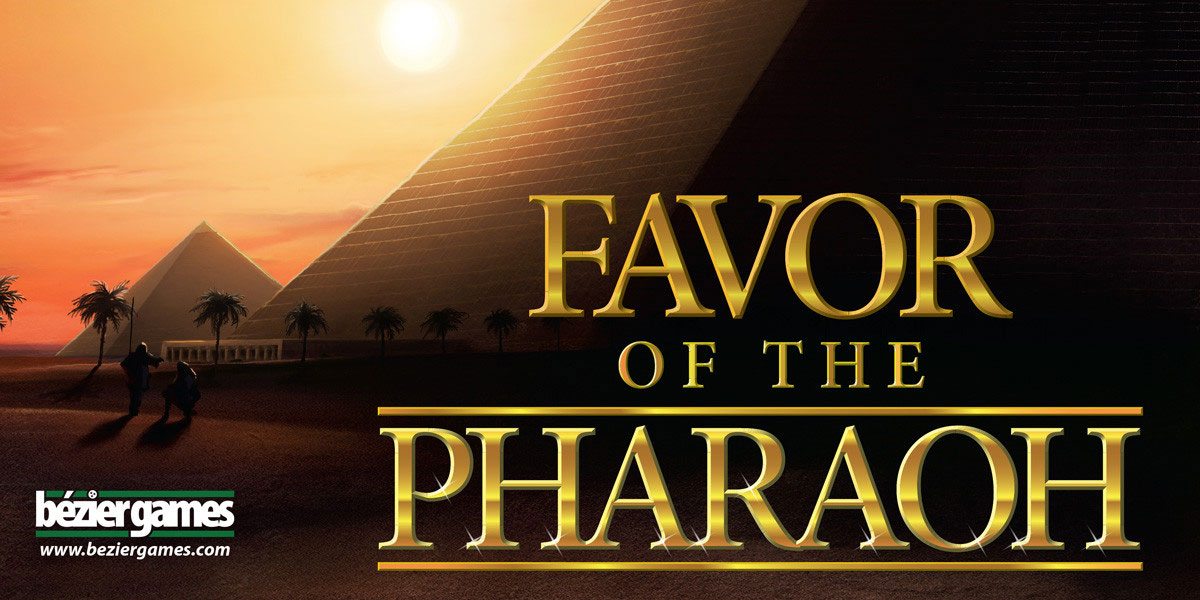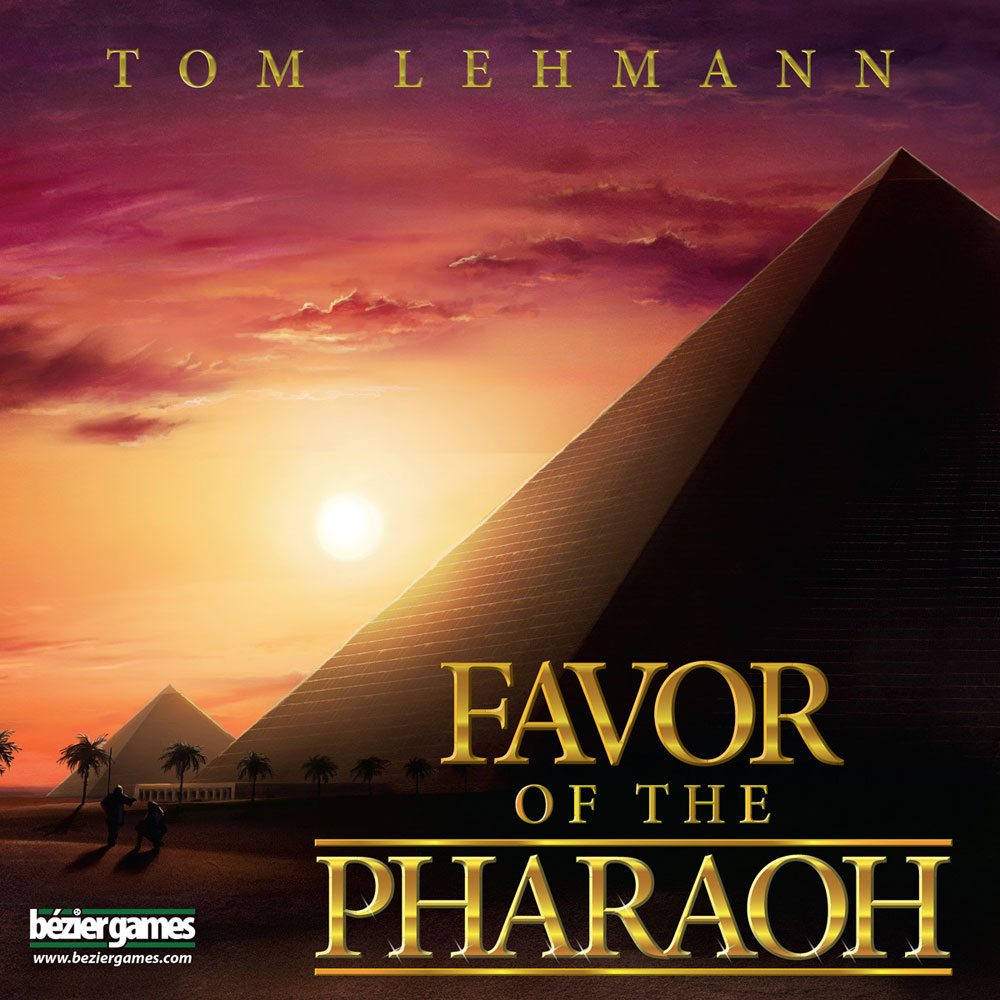Work your way up Egyptian society, collecting influence and favors. Once you’ve got the Queen on your side, you’re ready to seek the Favor of the Pharaoh.
At a glance: Favor of the Pharaoh is a game by Tom Lehmann for 2 to 4 players, ages 13 and up, and takes about 45 minutes to play. It retails for $59.95. I think the game could work for kids as young as 8 if they have some experience with games, particularly understanding dice probabilities, since there isn’t any content that is inappropriate.
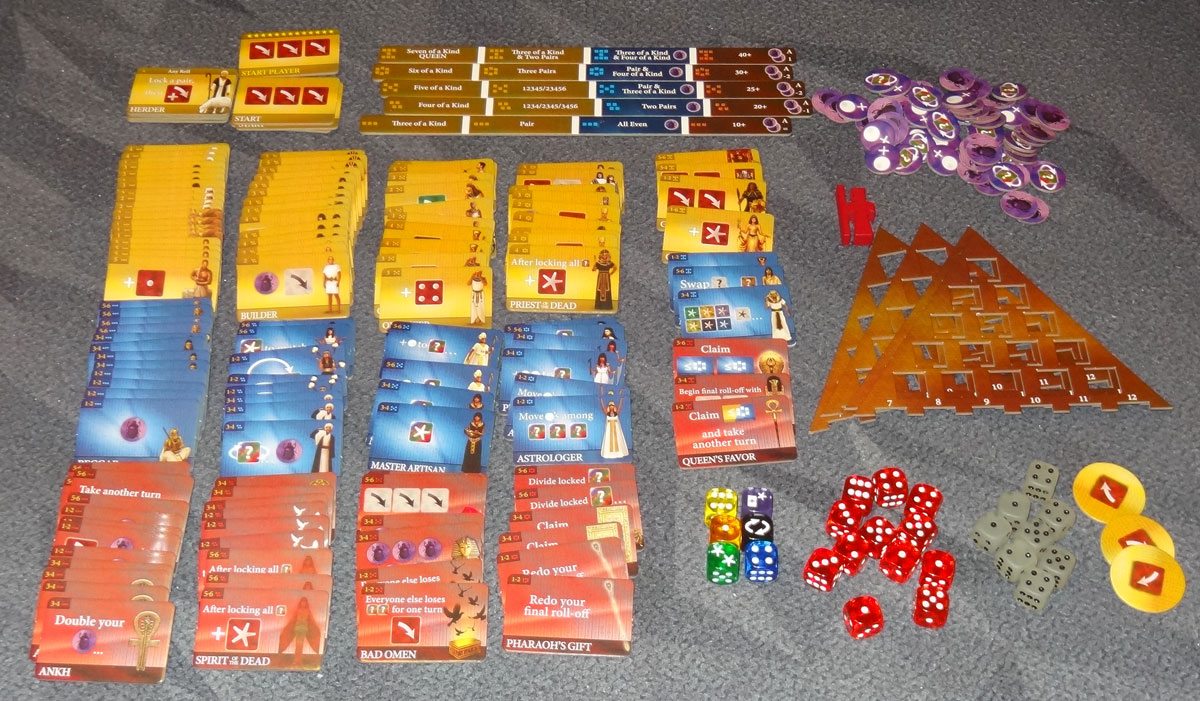
Components:
- 1 Pharaoh meeple
- 1 Start Player tile
- 3 Start tiles
- 4 Pyramids
- 63 Populace tiles (yellow)
- 36 Priesthood tiles (blue)
- 36 Artifact tiles (red)
- 3 “+1 Die” tokens
- 62 Scarab tokens (31 each “+1 Pip” and “Reroll”)
- 12 Standard dice (red)
- 8 Immediate dice (grey)
- 6 Custom dice (black, purple, yellow, green, blue, orange)
- 5 Double-Sided Level bars
The components for Favor of the Pharaoh are very nice. The cardboard all punches out easily and cleanly, and the illustrations fit the theme without being too distracting.

The dice are standard sized six-sided dice, though with some modifications. The Standard dice (red translucent) and Immediate dice (grey frosted translucent) have regular pips on them. The other dice are all modified–for instance, the orange Serf die has an extra 1 and 2 instead of the 5 and 6. Some of the others have special faces with asterisks or other icons on them.
The pyramids are used for “locking” your dice during your turn–there’s no reason other than theme for it to be shaped like a pyramid, but it works. The pyramids have holes (you’ll have to punch them out) for the dice, which is cool–again, not totally necessary but it’s nice to have them.

The Level bars indicate what you have to roll to take certain tiles, and they’re double-sided so you can mix up the setup each time you play. The “A” side seems to be a bit easier than the “B” side, in general.
All of the Populace, Priesthood, and Artifact tiles have a little icon in the top corner, indicating how many dice are needed for that tile (and showing which Level the tile is).
I should also make a special note about the box: the provided divider is fantastic. It’s a clear plastic insert with wells, and it holds and organizes all of the tiles. There are a couple of larger wells for the dice and the other tokens, though there’s no specific space provided for the Pyramids, which I usually just throw on top. There’s even a printed sheet with the cover art that goes underneath the insert, just for aesthetics. The only complaint I had about the divider was that there weren’t any instructions on what tiles go in which wells–they’re not all the same size, so this matters. Fortunately I was able to figure that out eventually, but to save you the trouble here’s a good setup.

Finally, there’s a reference sheet (separate from the rules) that gives you details about all of the level bars, the tiles, the dice, and the symbols on the tiles. It’s very handy to keep around while you’re playing the game until you become familiar with everything.
How to Play
The goal of the game is to win the Pharaoh’s favor by rolling at 7 of a kind. However, you’ll have to build up to that.
Each player starts with a Pyramid, a Start tile, and some number of scarab tokens based on turn order. One player will have the Start Player tile, indicating that person will play first.
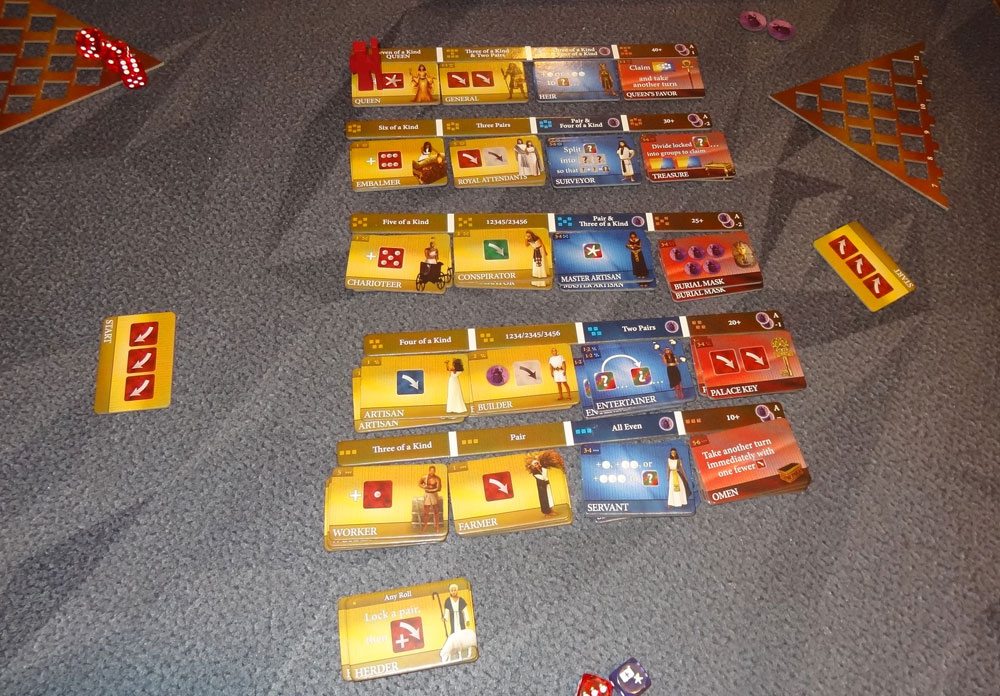
The Level bars and other tiles will be set up in the center of the table–there is a suggested setup for first time players, and for future games you can either randomize the setup by rolling dice or using the free companion app (for iOS or Android).
The Level bars show various combinations like “five of a kind” or “two pairs” or “15+,” and they are arranged from most dice (“seven of a kind”) to fewest (“three of a kind”). Then, below each bar, you will place four types of tiles: two Populace, 1 Priesthood, and 1 Artifact. The number of tiles of each type depends on the player count, but in general there are more of the low-level tiles and fewer of the high-level tiles.
The scarab tokens are turned face-down and mixed. (I put mine in an opaque bag.) The dice are placed in a supply on the table. The Pharaoh meeple is placed on the Queen tile.
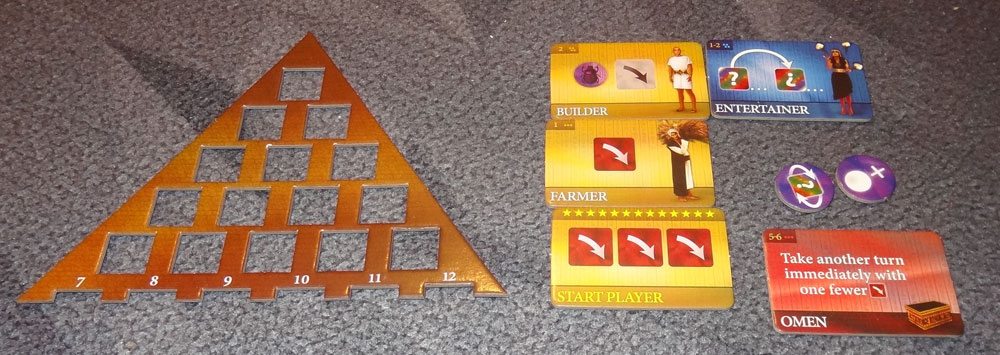
On your turn, you roll dice according to the icons shown on all of your available tiles. To start the game, you’ll have three Standard dice (as shown on your starting tile). As you gain other tiles over the course of the game, you will be able to roll more dice, sometimes of different types.
Each time you roll, you must lock at least one die (putting it onto your pyramid) before you can re-roll the rest. Scarab tokens may be used to add pips to a die or re-roll a die before locking. Once you have locked all of your dice, you may use the results to claim one tile as long as you fulfill the requirements shown. You may not buy multiple copies of the same tile. If you buy a Priesthood tile, you immediately claim a scarab token. If you buy an Artifact tile, you immediately claim two scarab tokens.
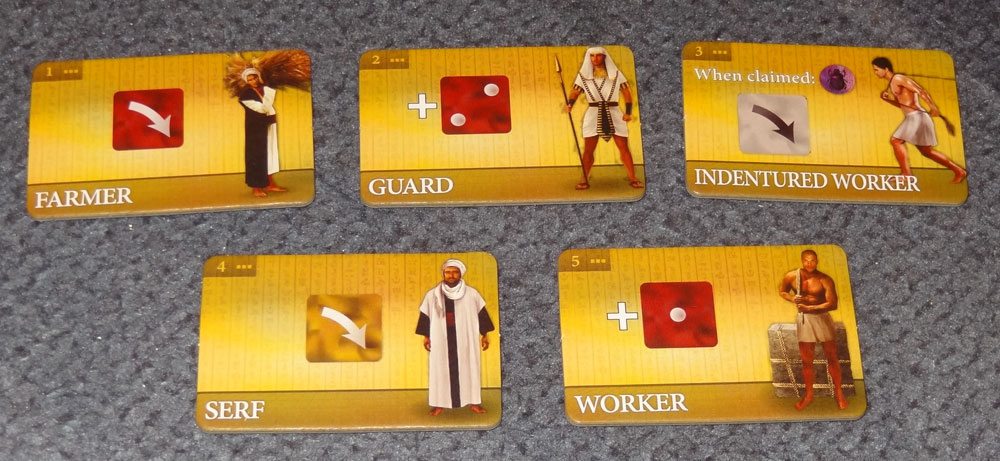
Populace tiles (yellow) give you more dice, either at the start of your turn or as dice that can be brought into play after a roll. Priesthood tiles (blue) have abilities that can be used once per turn, often to manipulate the values of active dice. Artifact tiles (red) are one-time-use powers, and are flipped over once used.

Play continues clockwise until a player claims the Queen (which requires at least 7 of a kind). The player takes both the Queen and the Pharaoh meeple, and marks the winning roll at the bottom of the Pyramid with a die. (For instance, if you rolled eight 2s, you would place a die showing a “2” on the slot marked “8” at the bottom of your pyramid.) Any player who has not had a turn yet this round takes a “+1 Die” token.
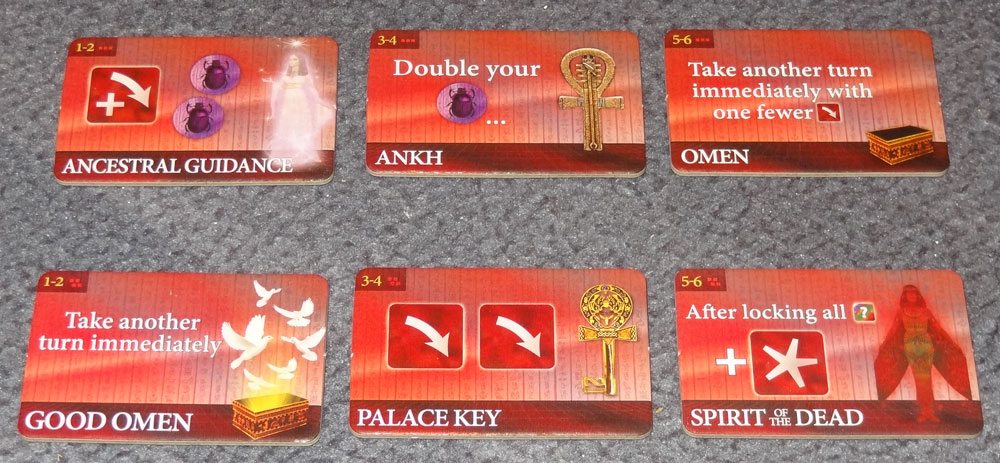
Each player now has one final turn for a roll-off, trying to beat the record set by the player who claimed the Queen. You must roll either a higher value, or a higher number of dice of any value. So if the current record is eight 2s, you can gain the Pharaoh’s Favor with eight 3s (or higher), or nine 1s (or higher). If there is no possible way for you to beat the current record because you simply can’t get enough dice, then you skip your turn.
If any other player takes the Pharaoh meeple, the player with the Queen will get one last chance to get it back. After that, whoever has the Pharaoh meeple has won the Favor of the Pharaoh.
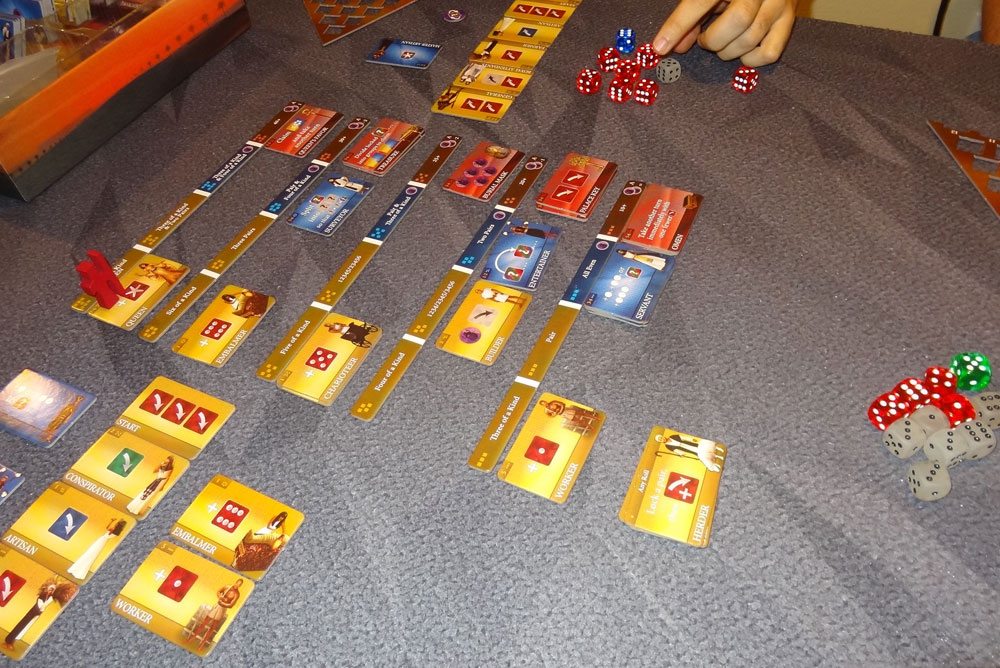
The Verdict
Favor of the Pharaoh is a reimplementation of Tom Lehmann’s 2006 game To Court the King. It isn’t just a simple retheme; it builds on the older game, particularly by including many more tiles so that the setup can vary each time you play.
It reminds me a little bit of a mashup of Yahtzee and Dominion. You’re trying to get various combinations with the dice–three of a kind, full house, a straight, and so on. But then instead of just getting points, you get tiles that build your ability to reach even better combinations. It’s engine-building, but with Yahtzee-style dice-rolling. I’ve played a few times and I’ve really enjoyed it. There’s a bit of playing with probabilities and trying to figure out which tile to go for each time, plus trying to hedge your bets so that you can get something even if the highest combo you’re going for falls through.
There can be some analysis paralysis for players who want to work out all the possibilities before they lock dice, and since it is a turn-based game, it can be a little less interesting if somebody is taking a really long time on their turn. This is especially true as the game progresses, because you have more and more dice to roll. One mitigating factor, though, is that since you may only purchase one of each tile (and because many of them are limited in number), your options for available purchases generally fall within a certain limit.
On the other hand, when the game is moving along, it goes pretty quickly. I played a 2-player game that actually took closer to 20 minutes, and I think familiarity with the game and what the tiles do would also help to shorten the game time.
The theme isn’t too strongly tied to the mechanics–again, I’m reminded somewhat of Dominion. Certain people have certain abilities, but it’s mostly kind of abstract. I feel like it’s the sort of game you’ll like or dislike based on the gameplay, not the theme.
All in all, though, I really enjoyed Favor of the Pharaoh. The component quality is great, and I’ve always liked Yahtzee-stye games, trying to get particular combinations and deciding which combinations I’m most likely to get. The strategy is medium weight–enough to give you something to think about but not so much that casual gamers can’t pick it up quickly. If you like dice combinations and building up an engine, check out Favor of the Pharaoh.
The game isn’t in stores yet, but is available for pre-order directly from Bezier Games and other online game stores, or you can check in with your friendly local game store and ask them to pre-order it for you. It should hit distribution in October.
Disclosure: I received a review copy of this game.
